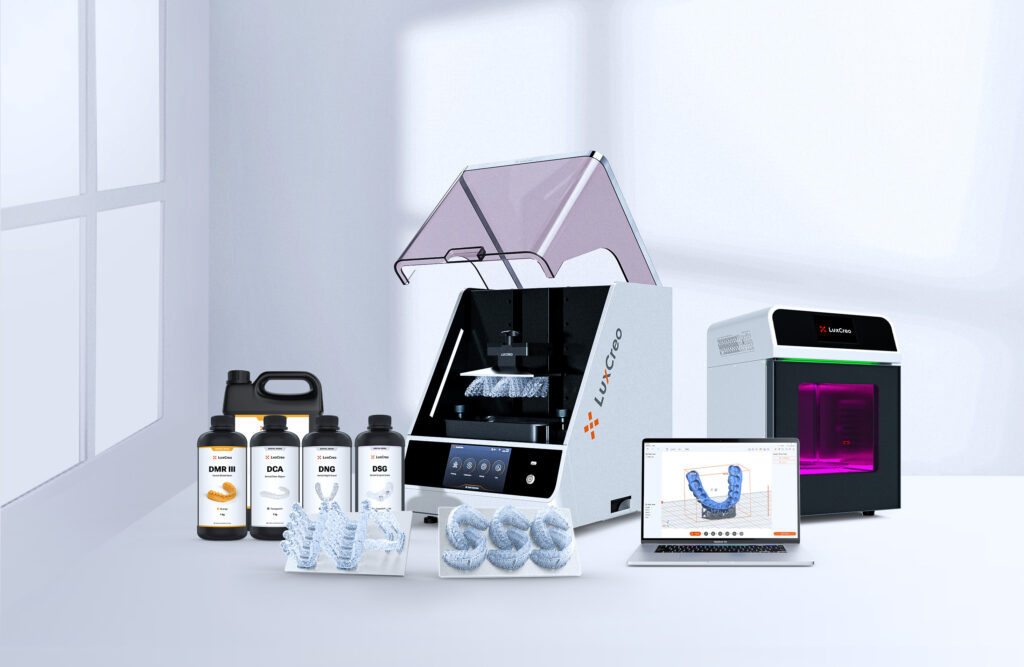Dental aligners made through thermoforming based on 3D printed inserts are one of the biggest additive manufacturing (AM) applications in the world. Pioneered by Align and now used by Smile Direct Club and others, we can estimate that over a million-and-a-half of these are 3D printed each working day.
It is, therefore, momentous to learn that U.S.-based LuxCreo has obtained an FDA Class II 510(k) clearance for directly 3D printed clear dental aligners. The company hopes to be able to produce aligners in less than two hours. This may enable the production of same-day clear aligners in the dentists office and will certainly accelerate production in labs. It could also cause more labs or orthodontists to switch from thermoforming to direct 3D printing, hence LuxCreo´s suite of products. The company also says that its direct aligners are more accurate and has quoted a dentist saying that he saved 60% in labor costs with direct 3D printed aligners.
“After 5 years of collaboration with orthodontists, dentists and dental labs, we are excited to introduce our integrated suite of direct aligner digital fabrication tools. LuxCreo direct print aligners offer higher accuracy compared to thermoformed alternatives which can result in a better patient fit. Furthermore, our patent-pending multi-thickness technology enables customized teeth movements tailored to each patient’s unique treatment needs,” said LuxCreo CEO Mike Yang said.

LuxCreo is developing an end-to-end solution for aligners consisting of a digital light processing (DLP) 3D printer, the iLux Pro Dental; LuxAlign software for automatically generating designs adding trim lines, repairing toothgaps, and performing other functions; a Direct Clear Aligner Material (DCA); iLuxCure Pro, for post-curing six to eight aligners in 30 minutes; and LuxScale, a way to order and send subsequent aligners to patients directly, with LuxCreo 3D printing them saving the orthodontist work. Thee printer itself is said to produce 64 direct aligners in eight hours. This is a great step for 3D printing and may see further penetration into the dental market, of which AM already generates some $3.1 billion per year, according to SmarTech Analysis.
From Indirect to Direct 3D Printed Aligners
Clear aligners made indirectly with patient-specific, 3D printed molds have created a $3.7 billion revenue behemoth in Align Technology and fundamentally disrupted the dental industry. Vat polymerization machines hum at all hours spitting out these photopolymer thermoforming inserts. But, what if there was a better way?
For years, a number of companies including Graphy, from Korea, and U.S.-based LuxCreo have been racing to develop directly 3D printed clear aligners that are flexible, tough, soft and approved for use in the mouth. With these products, the final aligner can be 3D printed directly, while saving on labor and process steps. We delve a bit deeper into the implications of that in this article.
Long considered the holy grail of vat photopolymerization, a successful clear aligner formulation could be a multi-billion dollar business in and of itself. However, we know that companies sometimes resist change or may want to wait and see. Additionally, it is difficult to implement new processes at scale. It is also possible that direct 3D printed clear aligner resin could be too expensive companies, inhibiting some from switching over.
Nevertheless, the LuxCreo suite of products could be a way in which individual orthodontists and small labs can strike back against Align and other direct-to-consumer giants by offering them a convenient clear aligner solution. This news is especially encouraging since, in the past, there have been some questions posed about cytotoxicity of certain photopolymers for vat polymerization. There are also general worries related people following the correct protocols needed in order to get safe, fully-cured components from vat photopolymerization. You can find an excellent paper on protocols and biocompatibility here. If LuxCreo manages to assuage these fears and comes up with a robust way to get dentists everywhere to make safe and good clear aligners, the firm could have a real winner on its hands.
Subscribe to Our Email Newsletter
Stay up-to-date on all the latest news from the 3D printing industry and receive information and offers from third party vendors.
Print Services
Upload your 3D Models and get them printed quickly and efficiently.
You May Also Like
The Market and Industry Potential of Multi-Material 3D and 4D Printing in Additive Electronics
Additive manufacturing leverages computer-based software to create components for products by depositing either dielectric or conductive materials, layer by layer, into different geometric shapes. Since its birth in the 1980s,...
3DPOD 262: Bio-inspired Design for AM with Dhruv Bhate, Arizona State University
Dhruv Bhate is an associate professor at Arizona State University. There, he looks at structures, materials, and design. Previously, he worked at PADT as well as in the semiconductor and...
3DPOD 261: Tooling and Cooling for AM with Jason Murphy, NXC MFG
Jason Murphy´s NXC MFG (Next Chapter Manufacturing) is not a generalist service; instead, the company specializes in making tooling. Using LPBF and binder jet, the company produces some of the...
3DPOD 260: John Hart on VulcanForms, MIT, Desktop Metal and More
John Hart is a Professor at MIT; he´s also the director of the Laboratory for Manufacturing and Productivity as well as the director of the Center for Advanced Production Technologies....
































